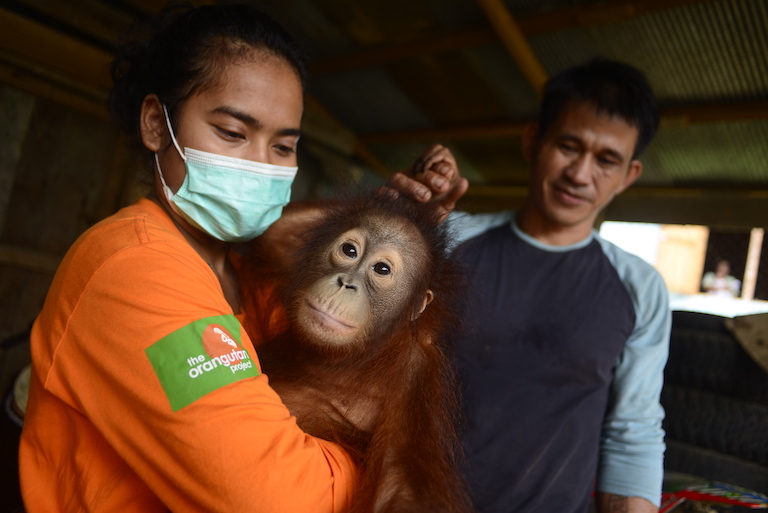- The months-long closure of national parks and continued travel restrictions due to COVID-19 has disrupted a critical revenue source for great ape conservation: sustainable tourism.
- Countries which rely on tourism as a significant source of their GDP must continue to place biodiversity principles at the heart of recovery efforts, and explore alternative livelihood options for local communities.
- Where great ape tourism is concerned, conservation must always be the primary goal of any endeavor.
- This article is a commentary, the views expressed are not necessarily those of Mongabay.
Although the exact source of the coronavirus outbreak is unknown, it has been widely reported to have originated with wildlife.
Since then, animals infected with COVID-19 include a small number of pet cats and dogs, farmed minks, and a group of lions and tigers in a New York zoo. Most of these animals were in contact with people who tested positive for SARS-CoV-2, the virus behind COVID-19, before they became ill.
Contagion risk for great apes
“Global mobility increases the risk for humans to contract diseases from animals, but it also increases the risk for humans to transmit diseases to animals, including great apes,” said Dr. Johannes Refisch, Program Manager for the Great Apes Survival Partnership at the UN Environment Program.
It is not yet confirmed whether great apes, an endangered primate group including orangutans, chimpanzees and gorillas who share the greatest similarity in DNA to humans, are susceptible to SARS-CoV-2, although Côte d’Ivoire had seen chimpanzees infected with the human coronavirus OC43 in the past.

The Ebola outbreak provides a notable example of a pandemic that devastated both humans and great apes: the hemorrhagic fever led to a surge in mortality rates of up to 95% among gorillas. It’s estimated that the already shrinking population numbers would take at least 130 years to recover.
Suspension of great ape tourism is another threat
The Virunga National Park in the Democratic Republic of Congo, Africa’s oldest national park and a UNESCO World Heritage Site, shut in late March to prevent the risk of COVID-19 infection among its gorilla and chimpanzee population. Virunga is home to one-third of the endangered mountain gorilla species whose population numbers worldwide are lower than a thousand.
Orangutan rehabilitation centers in Malaysia and Indonesia have also been closed to the general public. Wildlife sanctuaries and rescue centers are unable to release animals into the wild for fear of contagion risk, and continue to look after an ever growing number of wildlife, even as they can’t generate revenue from tourist visits.
“The end result is we are going through a funding crisis that I believe has not fully hit yet, while at the same time the conservation need has actually increased,” said Leif Cocks, Founder and President of The Orangutan Project, which seeks to safeguard the endangered red-haired primates and their disappearing habitats in Southeast Asia.
Now, parks in Rwanda and Uganda are gradually reopening to tourism after a period of closure due to COVID-19, although precautionary measures have been introduced, including temperature screening, social distancing rules and the compulsory wearing of masks.
As an example, UNESCO released a series of posters, with the support of the Sebitoli Chimpanzee Project in Uganda, with practical steps on how to protect great apes from the risk of virus transmission, and how to detect possible signs of disease.
“Many believe that without close contact from guests and feeding platforms, the experience will not be attractive for tourists. However, I don’t believe this is the case,” Cocks said. “Wildlife sanctuaries or rescue centers can occasionally allow visitations from a small number of donors and partners, however the guests should be supervised at all times and submit to hygiene and behavioral protocols, such as wearing face masks, and being medically screened for key diseases.”
See related: Market-based solutions cannot solely fund community-level conservation

Many experts opt for the adoption of the International Union for Conservation of Nature’s best practice guidelines for great ape tourism and disease prevention.
Ultimately, organizations that rely on visitors to finance conservation must strike a delicate balance between protecting these endangered species and generating sufficient revenue to fund critical law enforcement efforts which prevent illegal activities, including poaching or deforestation.
Diversifying beyond tourism
Tourism is often proposed as a primary means to fund conservation efforts, and to enable local communities to reap the ensuing employment opportunities.
Countries like Rwanda and Uganda that rely on great ape tourism as a top foreign exchange earner must, nonetheless, also consider the pandemic as a stark reminder to diversify their sources of economic income, and at the same time protect vulnerable ecosystems.
The recently launched Beyond Tourism in Africa innovation challenge is one example of endeavors targeted at developing new commercial solutions to diversify community livelihood from wildlife, and to safeguard biodiversity in the process.
So is sustainable great ape tourism still viable?
Great apes are already threatened by habitat loss and illegal hunting, and their potential vulnerability to the coronavirus serves as a timely reminder that economic interests should never take precedence over biodiversity principles – conservation must always be the primary goal of any great ape tourism endeavor.
Related podcast audio: Beyond tourism, conservation is a growth sector for the African economy:
Banner image: An adult male orangutan seen near the Sumatran Orangutan Rescue Centre, near Bukit Tigapuluh, Sumatra, Indonesia. Orangutans like this one are cared for after being illegally kept in captivity. Photo © Daniel Rosengren.
